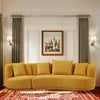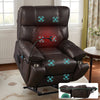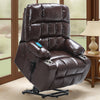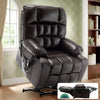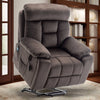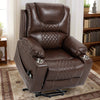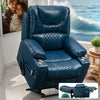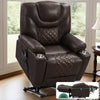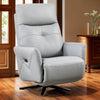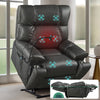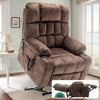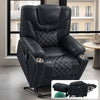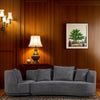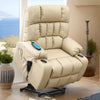Understanding Your Electric Recliner
Common components of big and tall power recliners
Big and tall power recliners offer enhanced comfort and support for larger body types. These robust chairs are built with several key components that ensure durability and a smooth reclining experience. The main elements include a reinforced frame for added strength, a wider seat, and taller backrest to accommodate bigger frames. They also feature a heavy-duty electric motor, which powers the reclining mechanism, allowing for easier adjustments and multiple reclining positions. The footrest is oversized for better leg support, and the padding is usually premium-quality foam for improved comfort. Additionally, many models incorporate user-friendly controls—located on a handheld remote or directly on the chair—for effortless operation. Together, these components work in sync to provide a comfortable and reliable seating solution for individuals of substantial stature.
How the electric mechanism works
To comprehend the functionality of a big and tall power recliner, it's crucial to understand the electric mechanism that powers it. This mechanism primarily comprises an electric motor, which drives a series of gears or levers. When you press the control buttons, signals are sent to the motor, prompting it to either extend or recline the chair. A transformer, connected to your home's power outlet, converts AC power to a lower voltage suitable for the recliner's use. Moreover, the recliner features limit switches that signal the motor to stop once the chair has reached its maximum extension or reclining position. This ensures both safety and the longevity of the recliner's parts. The seamless interplay between the motor, gears, transformer, and switches allows you to relax in multiple positions with just the touch of a button.
Common Issues with Electric Recliners
Power-related problems
Big and tall power recliners are designed to provide comfort and support, but like any electric furniture, they can have their share of issues. One of the most common problems owners may encounter is power-related. This can manifest as the recliner not responding to the control buttons or failing to maintain its position. There could be several reasons for these power issues, including faulty power outlets, a weakened connection between the power source and the recliner, or internal wiring problems. It's also possible that the power supply unit or transformer is malfunctioning, which is essential for converting the power to a suitable format for the recliner's motor. If you encounter such issues, it's crucial to first check if the recliner is plugged in correctly and the outlet is functional. Additionally, ensure that all cables are intact and firmly connected. If simple checks don't resolve the problem, it may be a sign of a more serious electrical fault within the unit.
Motor or mechanism failures
Motor or mechanism failures in big and tall power recliners can be quite frustrating. These essential parts are responsible for the smooth movement and adjustment of the chair. When they fail, your recliner may stop moving entirely or move in an irregular, jerky manner. Signs of a failing motor can include unusual noises when trying to recline or an outright inability to activate the reclining function. Mechanism failures, on the other hand, may manifest as resistance or obstructions while reclining — the feeling that something is stuck or not engaging correctly. Such issues could result from wear and tear, electrical problems, or foreign objects lodged in the mechanism. Identifying these issues early and addressing them is crucial to prevent further damage and ensure the recliner’s longevity.
Steps to Reset Your Electric Recliner
Safety precautions before starting
Before attempting to reset your electric recliner, it's crucial to ensure your safety and avoid any potential hazards. First, disconnect your recliner from the electrical outlet to prevent any accidental shocks or electrical surges. Remove any objects that could obstruct your access to the recliner’s moving parts, such as toys, rugs, or other small items. Additionally, wear non-conductive gloves if possible, to protect your hands from any sharp edges or mechanisms. Make sure the area is well-lit so that you can clearly see the components you're addressing. These initial steps will provide a safe environment for you to proceed with resetting your electric recliner.
Checking the power source
Before attempting to reset your electric recliner, it's essential to ensure that the power source is not the root of the issue. Start by checking if the recliner's power cord is firmly plugged into an electrical outlet. Sometimes, a loose connection can cause the recliner to malfunction. If the plug is in place, examine the outlet itself; it's worth trying a different outlet to rule out any problems with the power supply. Additionally, if your recliner uses a battery backup system, check to see if the batteries need to be replaced. A weak or dead battery can also lead to recliner performance issues. Once you're certain the power source is stable and providing electricity, you can confidently move on to resetting the motor of your electric recliner.
Resetting the motor
If you've discovered that your electric recliner isn't functioning properly, it might be necessary to reset the motor. This is a straightforward process that can often resolve basic issues. Begin by unplugging your recliner from the power source. This is critical to ensure your safety before attempting any fixes. Wait for a minute, then plug it back in. Next, locate the reset button, usually situated on the bottom of the chair or near the motor. Press and hold this button for a few seconds until you hear a beep or feel the chair vibrate, indicating the reset is complete. Turn on the power and check if the recliner is functioning correctly. Some models may require you to keep the footrest elevated during the reset process, so refer to your specific model's manual for detailed instructions.
Advanced Troubleshooting Techniques
Inspecting wiring and connections
When your big and tall power recliner malfunctions, it's essential to look beyond the basic fixes. Inspecting the wiring and connections is a crucial step that can resolve many technical issues. To start, unplug your recliner and locate the main wiring connections. These will typically be found under the chair or behind the backrest cushion. Gently disconnect the cables and inspect them for any signs of damage such as fraying or burns. The connectors should fit snugly without wobbling or being loose. If you notice any corrosion on the terminals, carefully clean them with a bit of sandpaper or a specialized contact cleaner. Check all ports and sockets for debris or obstructions that might impede the electrical connections. After thoroughly inspecting and cleaning the connections, reassemble them, ensuring a tight fit. Always handle wires carefully to prevent any further damage.
Lubricating moving parts
Maintaining your big and tall power recliner in optimal condition often involves routine lubrication of its moving parts. This proactive measure can significantly reduce friction and prevent wear and tear that might otherwise lead to malfunctions. Here's a simplicity-focused guide to get you started:
- Select the Right Lubricant: Utilize a lubricant that's specified for use on furniture mechanisms. Multi-purpose lubricants can also work, but ensure they're safe for your recliner's materials.
- Power Off the Recliner: Before proceeding, make sure the recliner is switched off and unplugged to avoid any electrical hazards.
- Locate the Moving Parts: Identify all the joints and components that enable the reclining action. Look for the metal hinges, levers, and the scissor mechanisms under the chair.
- Apply Lubricant: Spray or apply the lubricant sparingly on the moving parts, ensuring you reach the pivot points. Avoid over-lubrication to prevent attracting dirt and debris.
- Operate the Recliner: After lubrication, gently operate the recliner several times to help the lubricant distribute evenly.
- Wipe Excess Lubricant: Use a clean cloth to remove any excess lubricant that may have spilled over to avoid staining your flooring or the recliner's fabric.
Regularly applying lubricant to the moving parts of your electric recliner can extend its operational lifespan and provide you a smoother, more silent reclining experience. However, if lubrication does not resolve any stiffness or noise issues, further investigation into potential mechanical problems may be necessary.
When to Seek Professional Help
Signs of serious malfunction
Identifying signs of serious malfunction in your big and tall power recliner is crucial to preventing further damage and ensuring user safety. Key indicators include unusual sounds like grinding or clicking when the recliner moves, persistent unresponsiveness to control commands, and visible wear or fraying in the wiring. These signs suggest deeper electrical or mechanical failures that may not be safely resolved through basic troubleshooting. Observing any of these symptoms means it’s time to consult with a professional technician to prevent accidents or irreversible damage to your recliner.
Finding a qualified technician
When the troubleshooting steps do not solve the issues with your big and tall power recliner, it may be time to contact a qualified technician. Here's how to find one:
- Research Specialists: Look for technicians who specialize in furniture repair, specifically for electric recliners. You can start your search online or ask for recommendations at your local furniture store.
- Check Credentials: Ensure the technician has the necessary credentials and a solid reputation. Look for reviews or testimonials from previous customers.
- Ask About Experience: It's crucial to inquire about the technician's experience with large power recliners. They should be familiar with various brands and models.
- Get a Quote: Before making an appointment, ask for a detailed quote that includes the diagnosis, parts, and labor cost.
- Warranty and Guarantee: Find out if the service provided comes with a warranty or guarantee. This offers some security in case issues arise after the repair.
- Service Area: Confirm that the technician can service your area and that they understand the specific needs associated with handling big and tall power recliners.
By following these steps, you can ensure that you find a skilled and reliable technician to get your electric recliner back in action.
Maintenance Tips for Electric Recliners
Regular cleaning and inspection
Keeping your big and tall power recliner in top shape starts with regular cleaning and inspection. Dust and debris can accumulate in the crevices of your recliner, potentially affecting its operation over time. To maintain optimal performance, follow these simple steps:
- Weekly Cleaning: Use a soft cloth to wipe down your recliner. If your model has a removable cover, take it off and launder it according to the manufacturer's instructions.
- Monthly Inspection: Check for loose bolts or screws that may need tightening. Also, look for any signs of wear or damage to the reclining mechanism or power cord.
- Avoid Moisture: Ensure that no liquids are spilled on the electronic components. If your recliner does get wet, dry it immediately to prevent electrical issues.
- Vacuuming: Use a vacuum with a soft brush attachment to remove dust from under and around your recliner, paying special attention to the areas beneath the footrest.
By incorporating these practices into your routine, you'll extend the life of your electric recliner and enjoy a consistently comfortable experience.
Proper usage guidelines
To ensure the longevity and proper functioning of big and tall power recliners, it's essential to follow these proper usage guidelines:
- Weight Limits: Always adhere to the weight limit specified by the manufacturer. Exceeding it can cause undue stress on the motor and frame.
- Operating Speed: Operate the recliner at a steady speed without sudden starts or stops to prevent straining the motor.
- Positioning: Ensure the recliner is placed on a stable, level floor to avoid any imbalance or uneven pressure on the mechanism.
- Recline Range: Avoid forcing the recliner beyond its intended range of motion as this can damage the mechanical components.
- Objects Clearance: Keep the area around the recliner clear of objects that could obstruct motion or get caught in the moving parts.
Uphold these guidelines to maintain your electric recliner in peak condition and prevent unnecessary wear and tear.







